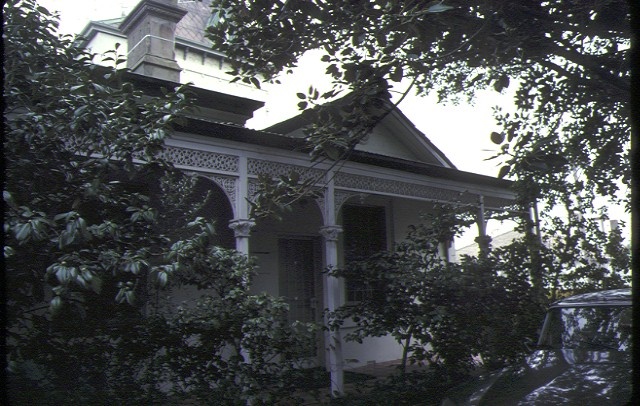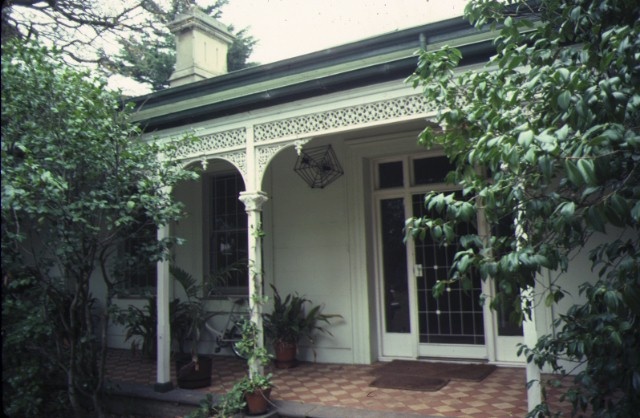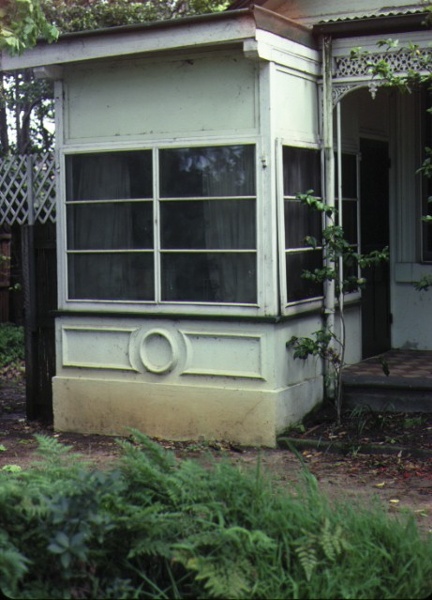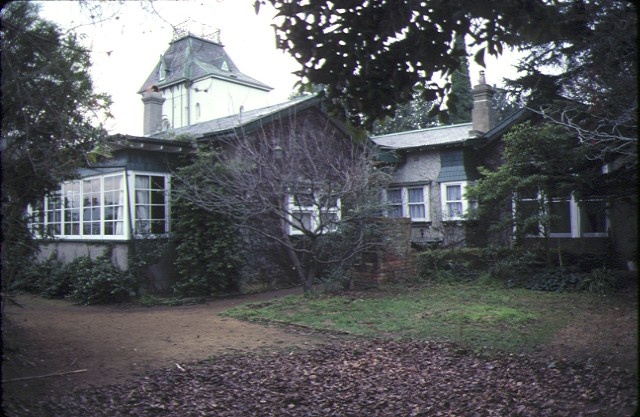Back to search results
HALSTEAD
23 BAMBRA ROAD CAULFIELD NORTH, GLEN EIRA CITY
HALSTEAD
23 BAMBRA ROAD CAULFIELD NORTH, GLEN EIRA CITY
All information on this page is maintained by Heritage Victoria.
Click below for their website and contact details.
Victorian Heritage Register
-
Add to tour
You must log in to do that.
-
Share
-
Shortlist place
You must log in to do that.
- Download report

HALSTEAD SOHE 2008











On this page:
Statement of Significance
What is significant?
Halstead, a single-storey villa residence with imposing three storey tower dating from at least 1857 including its garden setting and stables building.
How is it significant?
The Halstead is of architectural significance to the State of Victoria. It satisfies the following criteria for inclusion in the Victorian Heritage Register:
Criterion D
Importance in demonstrating the principal characteristics of a class of cultural places and objects
Criterion D
Importance in demonstrating the principal characteristics of a class of cultural places and objects
Why is it significant?
Halstead is a notable example of a fine mid-nineteenth century villa residence from c.1857 with pavilion wings and substantial three storey tower with Mansard roof, dormer windows and cast-iron balustraded ‘widow’s walk’. Built for wealthy pastoralist and station owner James Dickson and remaining in his family until the early twentieth century, it is believed to be the oldest standing residence in Caulfield. The construction of grand villas on the outskirts of Melbourne by wealthy settlers and their families, reflects the growing prosperity of the colony after the gold rush.
Show more
Show less
-
-
HALSTEAD - History
Caulfield
The area now known as Glen Eira was first inhabited by the Bunurong people. Today their land extends from the Werribee River to Westernport and further east and includes part of Melbourne and some of its suburbs, including Caulfield. European settlement and pastoral use of land in the Caulfield area dates from the 1840s. At that time, stockmen rested their cattle at Caulfield en route from Gippsland to Melbourne, along a stock route that was gradually replaced by Dandenong Road. In 1857 Caulfield was proclaimed a Road District (see map below). In 1871 Caulfield became a shire, and then a city in 1913. Today it is part of the City of Glen Eira local government area.
Villas and mansions
During the 1850s the discovery of gold brought great wealth to Melbourne, and Caulfield became a wealthy locality on the periphery of an expanding Melbourne. Caulfield North in particular became a desirable residential location. A number of large villas and mansions were built on substantial acreages by Melbourne’s gentry until the financial crash of the 1890s. Surviving examples include Halstead (c.1857) (VHR , Rosecraddock (c. 1857) (VHR H0589), Nithsdale (1858) (HO73), Kynaston (1888-89) (HO11), Rosemont (1868) (HO124), Clarence Lodge (HO212), as well as ornate boom era examples such as Labassa (1873, 1890) (VHR H0135) and Myoora (1886-87) (VHRH0490).1
Historians of Caulfield have called this period in the suburb’s development the ‘Mansion Era’.2 At this time, grand residences were developed in Caulfield, and across Melbourne, with generous garden settings that spoke to the prosperity, gentility and good taste of their owners. Halstead, a detached villa with stables and garden, was built c.1857 by wealthy pastoralist, James Dickson, on the outskirts of Melbourne, then a 10km journey by horse. Villas and mansions were often developed with towers, like the substantial three-storey structure at Halstead, which symbolised the owners’ wealth and status. Stables were necessary because of the reliance on horse travel, and gardens afforded privacy and shade within a larger acreage cleared for agriculture and grazing.
Despite a halt in development during the depression years of the 1890s, growth in Caulfield resumed during the first few decades of the early twentieth century. This period saw the subdivision of mansion estates into smaller allotments for further residential development, the expansion of the tramway system in the 1910s and improved highways by the interwar period. By the 1930s, Caulfield had transformed into a middle-class suburb characterised by freestanding houses designed in a mixture of Victorian, Federation and Interwar styles, and an increasing number of flats were being constructed.3
Halstead
Nineteenth century
Today Halstead (VHR H0450) is believed to be the oldest extant residence in Caulfield. The villa dates from at least 1857 and was owned and occupied by Dr James Dickson a wealthy pastoralist and property owner with large stations in the eastern colonies of Australia, including South Australia and the Riverina.4 It appears that Halstead was Dickson’s Melbourne residence. In 1858 the Halstead Estate comprised a brick residence on 14 acres of land, including 10 acres of pasture and 4 acres under cultivation. The house had six rooms with kitchen, servants’ rooms, stables and outbuildings. Dickson’s neighbour was James Bevan who built the substantial two-storey residence ‘Grosmont’ directly to the south of Halstead in the early 1860s (demolished 1933).
James Dickson lived at Halstead until his death in 1880 when his son George Dickson became the owner. George also owned Uabba and Maahope Stations in the Lachlan District of NSW and Uranaway Station in South Australia.5 In 1885 Ellen Dickson, James’ widow, was listed in the rate book as the owner of Halstead. She died there in 1893.6 By the early 1890s Halstead had been subdivided and the house block comprised two acres of land and a nine-roomed residence. By the late 1890s, George Dickson was again named as the owner in the rate books, the house having a series of tenants in that and the next decade. 7 A 1905 MMBW Plan show Halstead with its long verandah facing Bambra Road. There is a large front garden area, a building variously described in the 1970s as either servants' quarters or a services wing, and rear stables.
Twentieth century
In 1910 further subdivisions of Halstead were advertised for sale. The blocks comprised 54 ‘fine villa sites’ and ‘the recently renovated Halstead residence’.8 In 1911 Mr and Mrs SJ Plain purchased the residential block which had been reduced to 0.57 acres [0.23ha].9 A 1911 MMBW plan shows the residence within the boundaries of the subdivided block, with the newly made Halstead Street to the north from which the stables, comprised of three adjoining structures, could be accessed. After Mr and Mrs Ercil Plain purchased the residence, the servants' quarters/services wing was converted to a billiards rooms and attached to the house, which is shown on the 1911 MMBW plan.
After the death of Mr and Mrs Plain, the property passed to their daughter Mrs Ercil White (nee Plain). In 1977 after her death, it was sold to three development companies: Resco Nominees, Pty Ltd, Kathandra Pty Ltd, Camarda Pty Ltd. The occupying tenant was architect Vladmir Chernov. In 1978 Halstead was nominated for the Historic Buildings Register and was included in 1979.
Selected bibliography
Extent, Caulfield North Heritage Review, Volume 1, Prepared for City of Glen Eira (July 2023).
Carlotta Kellaway, Research into ‘Halstead’ 23 Bambra Road, Caulfield, National Trust of Australia (Victoria)
15 May 1978.
Peter Murray and John Wells, From sand, swamp and heath: A history of Caulfield, City of Caulfield, 1980.
Andrew Ward, ‘Halstead’ Citation, City of Glen Eira Heritage Management Plan, Volume 3, 1996,
unpaginated.
Peter Watts, ‘Halstead’ Research Notes, prepared for the National Trust of Australia (Victoria) 8 December
1978.
Footnotes
1 For an account of the development of Caulfield North, see Extent, Caulfield North Heritage Review, Volume 1, Prepared for City of
Glen Eira (July 2023).
2 Peter Murray and John Wells, From sand, swamp and heath: A history of Caulfield, City of Caulfield, 1980, p. 152. 3 Extent, Caulfield North Heritage Review.
4 'News of the Day', Age, 31 Dec 1880, p.2. Carlottta Kellaway, Research into ‘Halstead’ 23 Bambra Road, Caulfield, National Trust of
Australia (Victoria) 15 May 1978; Peter Murray and John Wells, From sand, swamp and heath: A history of Caulfield, City of Caulfield,
1980, p. 107.
5 Pastoral Times, (NSW) 3 June 1882, p.2
6 Carlottta Kellaway, Research into ‘Halstead’; 'Family Notices', Argus, Tue 17 Oct 1893, p.1.
7 Carlottta Kellaway, Research into ‘Halstead’; Andrew Ward, ‘Halstead’ Citation, City of Glen Eira Heritage Management Plan, Volume 3, 1996, unpaginated.
8 Argus, 23 Apr 1910, p. 3.
9 This is the extent currently under consideration, being the land in the VHR and that covered by the IPO (Lot 1 PS416790, the stable
lot, and Lot 1 LP129398, the eastern section of the front garden).HALSTEAD - Permit Exemptions
General Exemptions:General exemptions apply to all places and objects included in the Victorian Heritage Register (VHR). General exemptions have been designed to allow everyday activities, maintenance and changes to your property, which don’t harm its cultural heritage significance, to proceed without the need to obtain approvals under the Heritage Act 2017.Places of worship: In some circumstances, you can alter a place of worship to accommodate religious practices without a permit, but you must notify the Executive Director of Heritage Victoria before you start the works or activities at least 20 business days before the works or activities are to commence.Subdivision/consolidation: Permit exemptions exist for some subdivisions and consolidations. If the subdivision or consolidation is in accordance with a planning permit granted under Part 4 of the Planning and Environment Act 1987 and the application for the planning permit was referred to the Executive Director of Heritage Victoria as a determining referral authority, a permit is not required.Specific exemptions may also apply to your registered place or object. If applicable, these are listed below. Specific exemptions are tailored to the conservation and management needs of an individual registered place or object and set out works and activities that are exempt from the requirements of a permit. Specific exemptions prevail if they conflict with general exemptions. Find out more about heritage permit exemptions here.Specific Exemptions:The works and activities below are not considered to cause harm to the cultural heritage significance of Halstead subject to the following guidelines and conditions:
Guidelines
1. Where there is an inconsistency between permit exemptions specific to the registered place or object (‘specific exemptions’) established in accordance with either section 49(3) or section 92(3) of the Act and general exemptions established in accordance with section 92(1) of the Act specific exemptions will prevail to the extent of any inconsistency.
2. In specific exemptions, words have the same meaning as in the Act, unless otherwise indicated. Where there is an inconsistency between specific exemptions and the Act, the Act will prevail to the extent of any inconsistency.
3. Nothing in specific exemptions obviates the responsibility of a proponent to obtain the consent of the owner of the registered place or object, or if the registered place or object is situated on Crown Land the land manager as defined in the Crown Land (Reserves) Act 1978, prior to undertaking works or
activities in accordance with specific exemptions.
4. If a Cultural Heritage Management Plan in accordance with the Aboriginal Heritage Act 2006 is required for works covered by specific exemptions, specific exemptions will apply only if the Cultural Heritage Management Plan has been approved prior to works or activities commencing. Where there is an inconsistency between specific exemptions and a Cultural Heritage Management Plan for the relevant works and activities, Heritage Victoria must be contacted for advice on the appropriate approval pathway.
5. Specific exemptions do not constitute approvals, authorisations or exemptions under any other legislation, Local Government, State Government or Commonwealth Government requirements, including but not limited to the Planning and Environment Act 1987, the Aboriginal Heritage Act 2006, and the Environment Protection and Biodiversity Conservation Act 1999 (Cth). Nothing in this declaration exempts owners or their agents from the responsibility to obtain relevant planning, building or environmental approvals from the responsible authority where applicable.
6. Care should be taken when working with heritage buildings and objects, as historic fabric may contain dangerous and poisonous materials (for example lead paint and asbestos). Appropriate personal protective equipment should be worn at all times. If you are unsure, seek advice from a qualified heritage architect, heritage consultant or local Council heritage advisor
7. The presence of unsafe materials (for example asbestos, lead paint etc) at a registered place or object does not automatically exempt remedial works or activities in accordance with this category. Approvals under Part 5 of the Act must be obtained to undertake works or activities that are not expressly exempted by the below specific exemptions.
8. All works should be informed by a Conservation Management Plan prepared for the place or object. The Executive Director is not bound by any Conservation Management Plan and permits still must be obtained for works suggested in any Conservation Management Plan.
Conditions
1. All works or activities permitted under specific exemptions must be planned and carried out in a manner which prevents harm to the registered place or object.?Harm includes moving, removing or damaging any part of the registered place or object that contributes to its cultural heritage significance.
2. If during the carrying out of works or activities in accordance with specific exemptions original or previously hidden or inaccessible details of the registered place are revealed relating to its cultural heritage significance, including but not limited to historical archaeological remains, such as features, deposits or artefacts, then works must cease and Heritage Victoria notified as soon as possible.
3. If during the carrying out of works or activities in accordance with specific exemptions any Aboriginal cultural heritage is discovered or exposed at any time, all works must cease and the Secretary (as defined in the Aboriginal Heritage Act 2006) must be contacted immediately to ascertain requirements under the Aboriginal Heritage Act 2006.
4. If during the carrying out of works or activities in accordance with specific exemptions any munitions or other potentially explosive artefacts are discovered, Victoria Police is to be immediately alerted and the site is to be immediately cleared of all personnel.
5. If during the carrying out of works or activities in accordance with specific exemptions any suspected human remains are found the works or activities must cease. The remains must be left in place and protected from harm or damage. Victoria Police and the State Coroner’s Office must be notified immediately. If there are reasonable grounds to believe that the remains are Aboriginal, the State Emergency Control Centre must be immediately notified on 1300 888 544, and, as required under s.17(3)(b) of the Aboriginal Heritage Act 2006, all details about the location and nature of the human remains must be provided to the Secretary (as defined in the Aboriginal Heritage Act 2006).
Exempt works and activities
1. Removal and filling of the modern swimming pool to lawn level.
HALSTEAD - Permit Exemption Policy
It is recommended that a Conservation Management Plan is utilised to manage the place/object type in a manner which respects its cultural heritage significance.
-
-
-
-
-
ROSECRADDOCK
 Victorian Heritage Register H0589
Victorian Heritage Register H0589 -
PRIMARY SCHOOL NO.2586
 Victorian Heritage Register H1710
Victorian Heritage Register H1710 -
GRAND UNION TRAMWAY JUNCTION
 Victorian Heritage Register H0227
Victorian Heritage Register H0227
-
'Altona' Homestead (Formerly 'Laverton' Homestead) and Logan Reserve
 Hobsons Bay City
Hobsons Bay City
-
-












